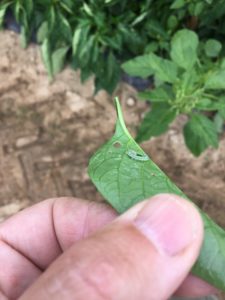Note: Due to the disruption caused by tropical storm Isaias, IPM technicians were unable to reach a number of blacklight and pheromone traps in the southern counties. Maps in this edition are representations of data from contributing traps.
Sweet Corn
European corn borer (ECB) adults remain very low, with only a few traps in the southern counties catching individuals consistently. Numbers are low and isolated such that no map will appear in this edition.
The highest nightly trap catches of ECB for the week ending 8/05/20 are as follows:
| Cinnaminson 1 | Medford 1 |
| Downer 1 | South Branch 1 |
| Green Creek 1 |
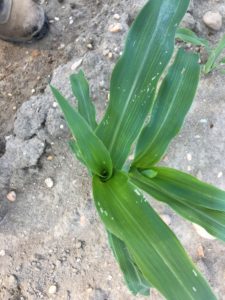
 Fall armyworm (FAW) larval infestations are persisting at generally low levels around the state. FAW could increase dramatically in the late summer, resulting in significant injury to whorl and even seedling stage corn. Injury from newly hatched larvae shows up as “window panes” or areas where leaf tissue has been eaten down the the lower epidermis (see photo at far left). This injury leads down into the whorl. As larvae gain size, they begin to consume leaf tissue in its’ entirety, creating ragged holes and lots of droppings (see photo at near left). FAW can be tough to manage because it is resistant to synthetic pyrethroid insecticides (IRAC 3A) and because larvae are often covered by their own droppings, making contact with the insecticide more difficult. Treat when 12% or more plants exhibit FAW injury alone, or in combination with ECB injury.
Fall armyworm (FAW) larval infestations are persisting at generally low levels around the state. FAW could increase dramatically in the late summer, resulting in significant injury to whorl and even seedling stage corn. Injury from newly hatched larvae shows up as “window panes” or areas where leaf tissue has been eaten down the the lower epidermis (see photo at far left). This injury leads down into the whorl. As larvae gain size, they begin to consume leaf tissue in its’ entirety, creating ragged holes and lots of droppings (see photo at near left). FAW can be tough to manage because it is resistant to synthetic pyrethroid insecticides (IRAC 3A) and because larvae are often covered by their own droppings, making contact with the insecticide more difficult. Treat when 12% or more plants exhibit FAW injury alone, or in combination with ECB injury.
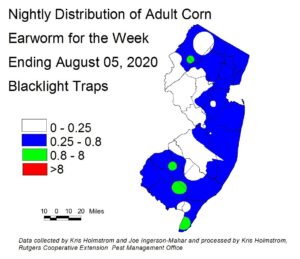 Corn earworm (CEW) moth captures have remained steady in blacklight traps this past week. This moderate mid-Summer population poses a significant risk to silking corn. Blacklight catches were highest overall along the Atlantic coast (see map at left), with blue areas on this map representing a 4-5 day spray schedule.
Corn earworm (CEW) moth captures have remained steady in blacklight traps this past week. This moderate mid-Summer population poses a significant risk to silking corn. Blacklight catches were highest overall along the Atlantic coast (see map at left), with blue areas on this map representing a 4-5 day spray schedule.
The highest nightly trap catches of CEW in black light traps for the week ending 8/05/20 are as follows:
| Allamuchy 2 | Downer 1 | Georgetown 1 |
| Bellemeade 1 | East Vineland 1 | Green Creek 1 |
| Crosswicks 1 | Farmingdale 1 | Hillsborough 1 |
| Denville 1 | Flanders 1 | Matawan 1 |
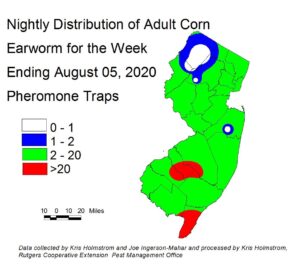 CEW pheromone trap catches are much the same as the previous week, with a slight increase in northern traps (see CEW pheromone map at left). Areas in white generally represent populations requiring 6-7 day spray schedules to manage, while blue areas are in the 5-6 day range. Green areas represent a 4-5 day schedule and red areas indicate a 3 day schedule. The number of pheromone traps deployed is much lower (and with even fewer reporting traps this week, due to the storm), resulting in much broader color bands on the map.
CEW pheromone trap catches are much the same as the previous week, with a slight increase in northern traps (see CEW pheromone map at left). Areas in white generally represent populations requiring 6-7 day spray schedules to manage, while blue areas are in the 5-6 day range. Green areas represent a 4-5 day schedule and red areas indicate a 3 day schedule. The number of pheromone traps deployed is much lower (and with even fewer reporting traps this week, due to the storm), resulting in much broader color bands on the map.
The highest nightly trap catches of CEW in pheromone traps for the week ending 8/05/20 are as follows:
| Elm 40 | Folsom 17 | Jones Island 7 |
| Berlin 39 | Califon 13 | Snyder Farm (Hunterdon) 6 |
| Green Creek 31 | Crosswicks 9 | Matawan 4 |
| East Vineland 20 | Dayton 8 | South Branch 4 |
Silking Spray Schedules*:
South – 3 – 4 days
Central – 4 days
North – 4 – 5 days
*These recommendations are based on regional catches. Adhere to tighter spray schedules if indicated by local trap catches. Synthetic pyrethroids alone should NOT be used for corn earworm (CEW) protection on silking corn, or for fall armyworm (FAW) management at any stage. Control with these materials is very inconsistent.
Pepper weevil (PW)
Previously noted PW infestations in southern NJ appear to be low. August is the month when PW infestations often appear and/or intensify, so growers should be alert to this possibility. Be on the lookout for large numbers of small fruit on the ground as an indication that PW are infesting fruit in the field.
As for control materials, Florida insecticide trials indicate that Actara, Vydate, Harvanta, and Torac provide the best results, however, there is a broad range of materials including pyrethroids and neonics that can kill the adults. The hope is to eliminate the weevil population before it becomes established in the field. A combination of spraying, trapping, and removal of aborted fruit would help to manage this pest.
If anyone wants pheromone traps or participate in a project of evaluating different lures, please contact Joe Ingerson-Mahar, mahar@sebs.rutgers.edu; phone: 856-889-5718.
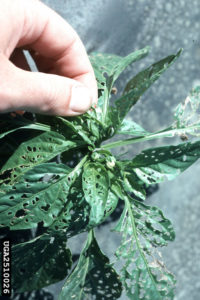 Although pheromone trap catches of beet armyworm (BAW) have declined in southern NJ, fewer traps were checked due to the storm. Growers should be alert to the potential for infestation from this pest. There was one report of very light feeding in peppers from the southern counties previously. Look for clusters of plants with lace-like damage to foliage near growing points (see photo at upper left). The green caterpillars will be found among these damaged leaves (see photo at lower left). After consuming foliage, BAW can begin to damage fruit directly. It is also important to note that BAW, like FAW, is resistant to synthetic pyrethroid insecticides. For this reason, materials in the IRAC 5 and 28 classes should be used in response to an infestation.
Although pheromone trap catches of beet armyworm (BAW) have declined in southern NJ, fewer traps were checked due to the storm. Growers should be alert to the potential for infestation from this pest. There was one report of very light feeding in peppers from the southern counties previously. Look for clusters of plants with lace-like damage to foliage near growing points (see photo at upper left). The green caterpillars will be found among these damaged leaves (see photo at lower left). After consuming foliage, BAW can begin to damage fruit directly. It is also important to note that BAW, like FAW, is resistant to synthetic pyrethroid insecticides. For this reason, materials in the IRAC 5 and 28 classes should be used in response to an infestation.
The highest nightly trap catches of BAW in pheromone traps for the week ending 8/05/20 are as follows:
| Woodstown 7 | Cedarvlle 2 |
| Folsom 4 |
Pumpkins and Winter Squash
A cucurbit downy mildew sentinel plot at Snyder Farm in Hunterdon County has thus far remained free of CDM. This plot, consisting of pumpkin, watermelon, cantaloupe, butternut, acorn, cucumber and kabocha squash is used to indicate the presence of cucurbit downy mildew in the region, and what crops are affected. As of 8/04/20, there was no CDM detected in this plot. For regional information on this important disease, see the Cucurbit Downy Mildew Forecast webpage: http://cdm.ipmpipe.org/. As of this Tuesday (8/048/20), New Jersey was rated at high risk for new infections by CDM. Regional infections to date have been on cucumber.
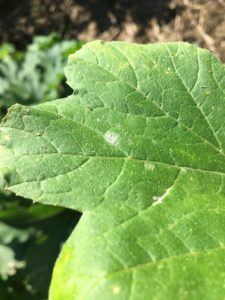
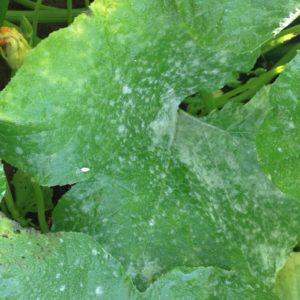 Increasing numbers of pumpkin/gourd fields in the scouting program have now reached the powdery mildew (PM) threshold. When scouting 50 plants (5 consecutive plants each, in 10 random locations), look within the canopy and observe the upper and lower surface of two older leaves per plant. PM generally doesn’t appear until fruit enlargement is occurring. Initial lesions will be fairly small and isolated (see photo at far left). As the disease progresses, lesions will spread out, giving the leaves a dusty appearance (see photo at near left). A PM fungicide prpogram incorporating both protectant and locally systemic materials should be initiated when PM is found on two or more leaves in a 50 plant (100 leaf) sample. Fungicides and suggested rotations are found in the Pumpkin and Winter Squash section of the Commercial Vegetable Production Recommendations. Consider the addition of copper hydroxide to the fungicide program if bacterial leaf spot has been detected in the field.
Increasing numbers of pumpkin/gourd fields in the scouting program have now reached the powdery mildew (PM) threshold. When scouting 50 plants (5 consecutive plants each, in 10 random locations), look within the canopy and observe the upper and lower surface of two older leaves per plant. PM generally doesn’t appear until fruit enlargement is occurring. Initial lesions will be fairly small and isolated (see photo at far left). As the disease progresses, lesions will spread out, giving the leaves a dusty appearance (see photo at near left). A PM fungicide prpogram incorporating both protectant and locally systemic materials should be initiated when PM is found on two or more leaves in a 50 plant (100 leaf) sample. Fungicides and suggested rotations are found in the Pumpkin and Winter Squash section of the Commercial Vegetable Production Recommendations. Consider the addition of copper hydroxide to the fungicide program if bacterial leaf spot has been detected in the field.
Tomatoes

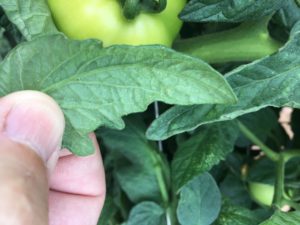 Two-spotted spider mite (TSSM) infestations continue to appear in tomato fields. These pests can build to high populations quickly and are a particular nuisance in high tunnels. Check two complete leaves each on 5 consecutive plants in 10 random locations in a planting. Look for the characteristic mite “stipple”, or whitish pin spots on the upper surface of the leaf (see photo at left). A check of the underside of the leaf should reveal the actual mites (photo at right). Be sure to take some samples from field or tunnel edges as this is often from where TSSM will enter the planting. Consider an miticide application if TSSM are found at more than one site in the sample. Miticide choices are found in the Tomato Section of the Commercial Vegetable Production Recommendations.
Two-spotted spider mite (TSSM) infestations continue to appear in tomato fields. These pests can build to high populations quickly and are a particular nuisance in high tunnels. Check two complete leaves each on 5 consecutive plants in 10 random locations in a planting. Look for the characteristic mite “stipple”, or whitish pin spots on the upper surface of the leaf (see photo at left). A check of the underside of the leaf should reveal the actual mites (photo at right). Be sure to take some samples from field or tunnel edges as this is often from where TSSM will enter the planting. Consider an miticide application if TSSM are found at more than one site in the sample. Miticide choices are found in the Tomato Section of the Commercial Vegetable Production Recommendations.
Brown Marmorated Stink Bug
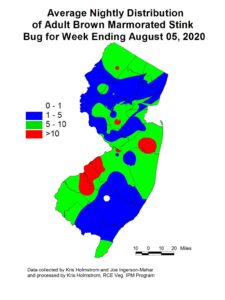 Brown marmorated stink bug (BMSB) activity has decreased slightly in blacklight traps throughout New Jersey. It is likely that these trap catches do not reflect population levels in a given area, but rather the activity of the bugs themselves. We often see numbers increase dramatically during heat waves like the one we are now experiencing. While this pest has generally declined as a threat to peppers, it remains a significant threat to tree fruit.
Brown marmorated stink bug (BMSB) activity has decreased slightly in blacklight traps throughout New Jersey. It is likely that these trap catches do not reflect population levels in a given area, but rather the activity of the bugs themselves. We often see numbers increase dramatically during heat waves like the one we are now experiencing. While this pest has generally declined as a threat to peppers, it remains a significant threat to tree fruit.
The highest nightly catches of BMSB in black light traps for the week ending 8/05/20 are as follows:
| Cinnaminson 18 | Downer 12 | Green Creek 8 |
| Farmingdale 18 | Clinton 11 | Medford 8 |
| Bellemeade 16 | Hackettstown 9 | Springdale 8 |
| Crosswicks 14 | Sparta 9 | Chester 6 |
